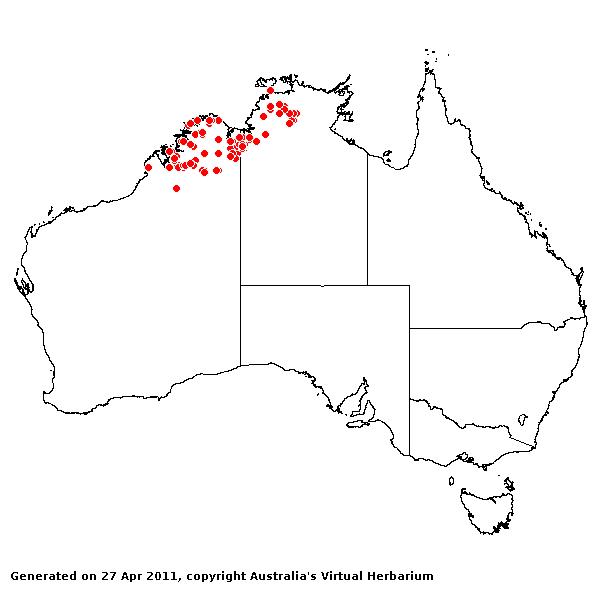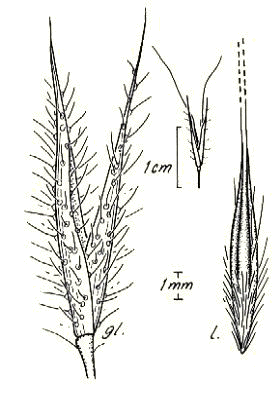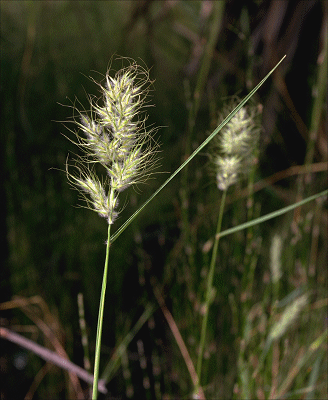Eriachne sulcata Hartley. J. Linn.
Soc., Bot 52: 342 (1942).
Classification. (GPWG 2001) : Subfamily
Micrairoideae. Eriachneae.
Type of Basionym or
Protologue Information: HT: W.V. Fitzgerald 315, Apr 1905,
Australia: Western Australia: Northern Province: 9 mi from Goody Goody (K; IT:
PERTH).
Key references
(books and floras): [1952] C.A.Gardner, Flora of Western Australia 1
Gramineae (48), [2002] D.Sharp & B.K.Simon, AusGrass, Grasses of
Australia.
Illustrations:
[2005] K.Mallet (ed.), Flora of Australia 44B: Poaceae 3 (Fig.
25A-B).
Habit.
Perennial. Culms erect, 30–80 cm tall. Mid-culm nodes bearded. Lateral branches
simple or sparsely branched. Ligule a fringe of hairs. Leaf-blades involute,
10–30 cm long, 1–7 mm wide. Leaf-blade surface smooth or scabrous, glabrous or
indumented.
Inflorescence.
Inflorescence compound, a panicle. Panicle oblong or ovate, 4–13 cm long, 1–4
cm wide.
Spikelets.
Spikelets pedicelled. Fertile spikelets 2-flowered, both fertile, comprising 2
fertile floret(s), without rachilla extension, ovate, laterally compressed,
6–10 mm long.
Glumes. Glumes
similar, thinner than fertile lemma. Lower glume ovate, membranous, without
keels, 9–11 -nerved. Lower glume surface indumented. Lower glume apex muticous
or awned. Upper glume ovate, 5.5–8.5(–10) mm long, membranous, without keels,
9–11 -nerved. Upper glume surface indumented. Upper glume apex muticous or
awned.
Florets.
Fertile lemma 5–8 mm long, without keel, 7 -nerved. Lemma surface indumented.
Lemma apex awned, 1 -awned. Median (principal) awn 10–35 mm long overall. Palea
apex dentate. Grain 2.5–4 mm long.
Continental
Distribution: Australasia.
Australian
Distribution: Western Australia, Northern Territory.
Western Australia:
Gardner, Fitzgerald, Dampier. Northern Territory: Darwin & Gulf,
Victoria River.
Notes.
Distinguishing characters include bearded and tubercled culm nodes, dense
panicles, stiffly hirsute hardened sometimes aristulate glumes, awned bisulcate
lemmas, and shortly beaked paleas. Eriachne pauciflora has similarities
with E. sulcata but differs by its looser panicles, smaller spikelets,
florets longer than glumes, shortly acute or obtuse glumes with a usually
sparser indumentum, and by a longer lemma awn. In appearance and morphology, E.
sulcata resembles E. schultziana, but in the latter species the
spikelet is larger, the lemma totally concealed by indumentum, the glumes are
sometimes glabrous and smooth, and the apical beak and two awnlets of the palea
are longer.
Endemic.
Common N of 18ºS in W.A., and rare in N.T. as far east as Kakadu Natl Park.
Deep or shallow, sandy or heavy-textured soils, salt flats, outcrops or
hillslopes of granite and sandstone, and seasonally wet alluvial sites such as
floodouts, drainage channels, waterways and seepage. Flowers and fruits
Mar.-Aug. (autumn-winter).




